The global DFB narrow linewidth single frequency lasers market is valued at USD 575.4 million in 2025. It is slated to reach USD 1,080.1 million by 2035, recording an absolute increase of USD 504.7 million over the forecast period. Demand for DFB narrow linewidth single-frequency lasers is projected to grow at 87.7%, with the DFB narrow linewidth single frequency lasers market forecast to expand at a compound annual growth rate of 6.5% between 2025 and 2035. The overall market size is expected to grow by nearly 1.88 times during the same period, supported by increasing demand for high-precision optical communications, growing adoption of DFB lasers in advanced sensing applications, and rising emphasis on coherent optical systems across diverse telecommunications, medical diagnostic, and industrial measurement applications.
Between 2025 and 2030, the DFB narrow linewidth single frequency lasers market is projected to expand from USD 575.4 million to USD 788.4 million, resulting in a value increase of USD 213 million, which represents 42.2% of the total forecast growth for the decade. This phase of development will be shaped by increasing fiber optic network deployments and 5G infrastructure requirements, rising adoption of advanced gas sensing systems for environmental monitoring, and growing demand for high-stability laser sources in medical diagnostics and quantum computing applications. Telecommunications operators and industrial sensor manufacturers are expanding their DFB laser capabilities to address the growing demand for narrow linewidth and high-frequency stability solutions that ensure signal quality and measurement precision.
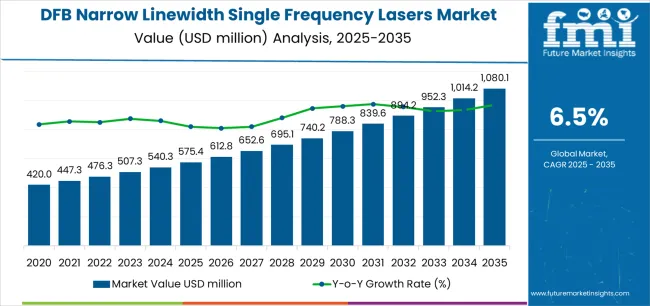
From 2030 to 2035, the DFB narrow linewidth single frequency lasers market is forecast to grow from USD 788.4 million to USD 1,080.1 million, adding another USD 291.7 million, which constitutes 57.8% of the overall ten-year expansion. This period is expected to be characterized by the expansion of quantum communication networks and LiDAR systems for autonomous vehicles, the development of ultra-narrow linewidth lasers for atomic clocks and gravitational wave detection, and the growth of specialized applications for optical coherence tomography and precision spectroscopy. The growing adoption of photonic integrated circuits and silicon photonics platforms will drive demand for DFB lasers with enhanced wavelength stability and reduced phase noise characteristics.
Between 2020 and 2025, the DFB narrow linewidth single frequency lasers market experienced steady growth, driven by increasing fiber optic communication bandwidth requirements and growing recognition of narrow linewidth lasers as essential components for enhancing signal integrity and transmission distance in long-haul optical networks. The DFB narrow linewidth single frequency lasers market developed as telecommunications engineers and optical system designers recognized the potential for DFB laser technology to enhance coherent detection performance, improve frequency stability, and support advanced modulation formats while meeting stringent wavelength accuracy requirements. Technological advancement in semiconductor laser fabrication and distributed feedback grating design began emphasizing the critical importance of maintaining single-mode operation and temperature stability control in demanding communication and sensing environments.
| Metric | Value |
|---|---|
| Estimated Value in (2025E) | USD 575.4 million |
| Forecast Value in (2035F) | USD 1,080.1 million |
| Forecast CAGR (2025 to 2035) | 6.5% |
Market expansion is being supported by the increasing global demand for high-capacity fiber optic communication systems driven by data center expansion and 5G network deployment, alongside the corresponding need for advanced laser sources that can enhance transmission performance, enable coherent detection schemes, and maintain frequency stability across various telecommunications, sensing, medical, and scientific research applications. Modern telecommunications operators and industrial system integrators are increasingly focused on implementing DFB narrow linewidth laser solutions that can improve signal quality, enhance detection sensitivity, and provide consistent performance in demanding operational conditions.
The growing emphasis on precision measurement and environmental monitoring is driving demand for DFB lasers that can support gas sensing applications, enable trace gas detection, and ensure comprehensive analytical performance. Industrial manufacturers' preference for laser sources that combine narrow spectral width with wavelength stability and output power efficiency is creating opportunities for innovative DFB laser implementations. The rising influence of quantum technology development and autonomous vehicle LiDAR systems is also contributing to increased adoption of DFB lasers that can provide superior coherence length without compromising reliability or cost-effectiveness.
The DFB narrow linewidth single frequency lasers market is segmented by output power, application, and region. By output power, the DFB narrow linewidth single frequency lasers market is divided into mW-10mW, 10mW-20mW, and over 20mW categories. Based on application, the DFB narrow linewidth single frequency lasers market is categorized into telecommunication, gas sensing, medical, data center, and others. Regionally, the DFB narrow linewidth single frequency lasers market is divided into East Asia, Europe, North America, South Asia, Latin America, Middle East & Africa, and Eastern Europe.
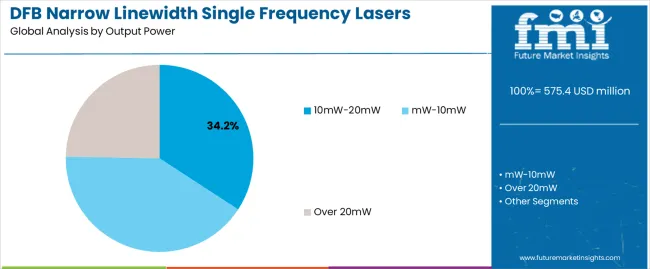
The 10mW-20mW output power segment is projected to maintain its leading position in the DFB narrow linewidth single frequency lasers market in 2025 with a 34.2% market share, reaffirming its role as the preferred power category for telecommunications coherent detection and optical sensing applications. Telecommunications equipment manufacturers and sensing system developers increasingly utilize 10mW-20mW DFB lasers for their optimal balance between output power and linewidth performance, excellent frequency stability, and proven effectiveness in supporting long-distance fiber optic transmission while maintaining signal integrity. This power range technology's proven effectiveness and application versatility directly address the industry requirements for coherent optical communication systems and precision measurement instruments across diverse network architectures and sensing configurations.
This output power segment forms the foundation of modern coherent optical systems, as it represents the power level with the greatest contribution to signal-to-noise ratio improvements and established performance record across multiple telecommunications and sensing applications. Telecommunications industry investments in coherent detection technologies continue to strengthen adoption among network equipment manufacturers and optical component suppliers. With regulatory pressures requiring higher bandwidth capacity and improved transmission efficiency, 10mW-20mW DFB lasers align with both performance objectives and cost requirements, making them the central component of comprehensive optical network strategies.
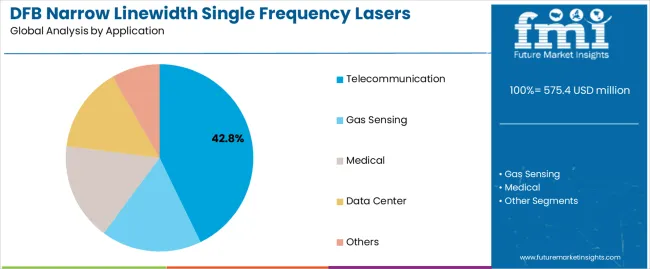
The telecommunication application segment is projected to represent the largest share of DFB narrow linewidth single frequency lasers demand in 2025 with a 42.8% market share, underscoring its critical role as the primary driver for DFB laser adoption across coherent optical communication systems, fiber optic transmission networks, and high-speed data transport applications. Telecommunications operators prefer DFB narrow linewidth lasers for coherent detection due to their exceptional frequency stability, narrow spectral width, and ability to support advanced modulation formats while enabling long-distance transmission and high-sensitivity detection. Positioned as essential components for modern optical communication systems, DFB lasers offer both performance advantages and operational reliability.
The segment is supported by continuous innovation in coherent optical technology and the growing availability of advanced DFB laser designs that enable superior transmission performance with enhanced wavelength accuracy and reduced phase noise. Additionally, telecommunications operators are investing in comprehensive laser integration programs to support increasingly demanding bandwidth requirements and network capacity expansion initiatives. As fiber optic network deployments accelerate and coherent detection adoption increases, the telecommunication application will continue to dominate the DFB narrow linewidth single frequency lasers market while supporting advanced DFB laser utilization and optical system performance optimization strategies.
The DFB narrow linewidth single frequency lasers market is advancing steadily due to increasing demand for coherent optical communication systems driven by data center interconnect requirements and growing adoption of advanced sensing technologies that require high-stability laser sources providing enhanced frequency control and narrow spectral characteristics across diverse telecommunications, industrial, and scientific applications. However, the DFB narrow linewidth single frequency lasers market faces challenges, including high manufacturing costs and complex fabrication processes, competition from alternative laser technologies and frequency stabilization methods, and supply chain constraints related to specialized semiconductor materials and precision manufacturing capabilities. Innovation in photonic integration technologies and wavelength tuning mechanisms continues to influence product development and market expansion patterns.
The growing deployment of coherent optical communication systems is driving demand for narrow linewidth laser sources that address stringent performance requirements including low phase noise, high frequency stability, and precise wavelength control for advanced modulation formats. Coherent detection systems require DFB lasers with sub-megahertz linewidth characteristics that deliver superior signal quality across multiple transmission parameters while maintaining cost-effectiveness and reliability. Telecommunications equipment manufacturers are increasingly recognizing the competitive advantages of narrow linewidth DFB laser integration for next-generation optical network development and technology differentiation, creating opportunities for innovative laser designs specifically optimized for coherent detection applications.
Modern gas sensing applications are incorporating narrow linewidth DFB lasers to enhance detection sensitivity, enable trace gas measurement, and support comprehensive environmental monitoring through tunable diode laser absorption spectroscopy techniques. Leading sensor manufacturers are developing wavelength-specific DFB lasers for methane detection, carbon dioxide monitoring, and industrial process control applications, implementing precise wavelength targeting strategies, and advancing laser designs that minimize detection limits while maximizing measurement accuracy. These technologies improve analytical capabilities while enabling new sensing opportunities, including atmospheric composition analysis, greenhouse gas monitoring, and industrial safety applications. Advanced sensing integration also allows manufacturers to support comprehensive environmental compliance objectives and measurement accuracy beyond traditional detection methods.
The expansion of quantum communication networks, atomic clock systems, and gravitational wave detection is driving demand for ultra-narrow linewidth DFB lasers with exceptional frequency stability and precisely controlled emission characteristics. These advanced applications require specialized laser sources with linewidth below 100 kHz and long-term frequency drift specifications that exceed traditional telecommunications requirements, creating premium market segments with differentiated performance criteria. Manufacturers are investing in advanced cavity stabilization techniques and temperature control systems to serve emerging quantum technology applications while supporting innovation in fundamental physics research and precision metrology.
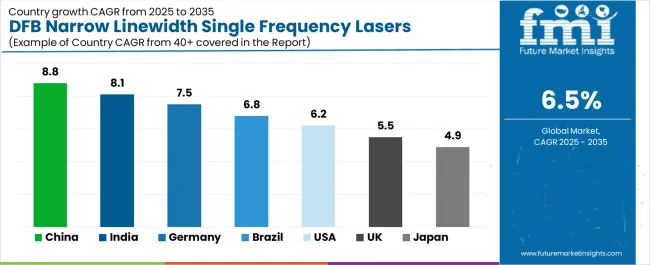
| Country | CAGR (2025-2035) |
|---|---|
| China | 8.8% |
| India | 8.1% |
| Germany | 7.5% |
| Brazil | 6.8% |
| United States | 6.2% |
| United Kingdom | 5.5% |
| Japan | 4.9% |
The DFB narrow linewidth single frequency lasers market is experiencing solid growth globally, with China leading at an 8.8% CAGR through 2035, driven by expanding telecommunications infrastructure and 5G network deployment, growing fiber optic manufacturing capacity, and increasing adoption of advanced sensing systems in industrial and environmental monitoring applications. India follows at 8.1%, supported by telecommunications network expansion, emerging data center infrastructure, and growing demand for optical components in fiber-to-the-home deployments. Germany shows growth at 7.5%, emphasizing precision manufacturing, automotive LiDAR applications, and advanced sensor integration in industrial automation systems.
Brazil demonstrates 6.8% growth, supported by telecommunications network modernization, expanding fiber optic coverage, and increasing demand for optical components in urban network infrastructure. The United States records 6.2%, focusing on data center coherent optics, quantum technology research, and advanced medical diagnostic applications. The United Kingdom exhibits 5.5% growth, emphasizing telecommunications equipment manufacturing and research institution applications. Japan shows 4.9% growth, supported by advanced optical component manufacturing and precision measurement instrument production.
The report covers an in-depth analysis of 40+ countries, the top-performing countries are highlighted below.
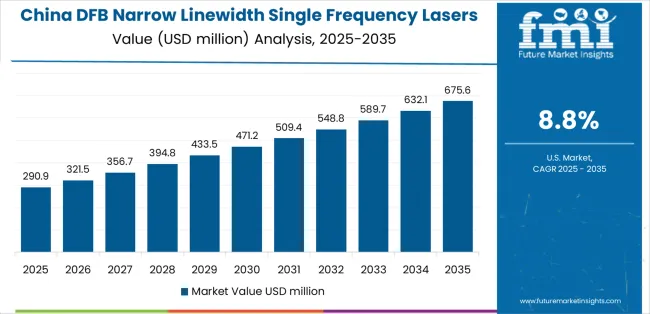
Revenue from DFB narrow linewidth single frequency lasers in China is projected to exhibit exceptional growth with a CAGR of 8.8% through 2035, driven by massive telecommunications infrastructure deployment and 5G network rollout supported by government digital infrastructure initiatives and comprehensive fiber optic network expansion programs. The country's extensive telecommunications sector growth and increasing investment in coherent optical technologies are creating substantial demand for narrow linewidth laser solutions. Major optical component manufacturers and telecommunications equipment suppliers are establishing comprehensive DFB laser production capabilities to serve both domestic markets and export opportunities.
Revenue from DFB narrow linewidth single frequency lasers in India is expanding at a CAGR of 8.1%, supported by telecommunications network modernization initiatives, expanding data center infrastructure, and increasing demand for optical components in fiber-to-the-home deployments and enterprise network applications. The country's comprehensive digital transformation programs and technology adoption are driving sophisticated optical component capabilities throughout telecommunications and industrial sectors. Leading telecommunications operators and optical component manufacturers are establishing production and assembly facilities to address growing domestic demand.
Revenue from DFB narrow linewidth single frequency lasers in Germany is expanding at a CAGR of 7.5%, supported by the country's precision optical manufacturing capabilities, expanding automotive LiDAR development, and strong industrial automation sector utilizing narrow linewidth lasers in measurement and sensing applications. The nation's advanced technology infrastructure and engineering excellence are driving sophisticated DFB laser capabilities throughout automotive and industrial sectors. Leading optical component manufacturers and automotive suppliers are investing extensively in advanced laser technologies and specialized applications.
Revenue from DFB narrow linewidth single frequency lasers in Brazil is expanding at a CAGR of 6.8%, supported by telecommunications network modernization programs, expanding fiber optic infrastructure deployment, and growing demand for optical components in urban network expansion and enterprise connectivity applications. The nation's telecommunications sector development and infrastructure investment are driving demand for advanced optical component solutions. Telecommunications operators and equipment suppliers are investing in network capacity expansion and technology upgrades to serve both metropolitan and emerging markets.
Revenue from DFB narrow linewidth single frequency lasers in the United States is expanding at a CAGR of 6.2%, supported by the country's leadership in data center coherent optics, established quantum technology research programs, and growing emphasis on advanced medical diagnostic applications utilizing narrow linewidth laser sources. The nation's comprehensive telecommunications infrastructure and technology innovation ecosystem are driving demand for sophisticated DFB laser solutions. Optical component manufacturers and technology companies are investing in production capacity expansion and next-generation laser development to serve both domestic and international markets.
Revenue from DFB narrow linewidth single frequency lasers in the United Kingdom is expanding at a CAGR of 5.5%, driven by the country's telecommunications equipment manufacturing sector, research institution applications, and precision measurement instrument production supporting narrow linewidth laser adoption. The United Kingdom's optical component expertise and research capabilities are driving demand for advanced DFB laser products. Leading telecommunications equipment suppliers and research organizations are investing in specialized laser technologies for communications and scientific applications.
Revenue from DFB narrow linewidth single frequency lasers in Japan is expanding at a CAGR of 4.9%, supported by the country's leadership in optical component manufacturing, precision instrumentation production, and strong emphasis on high-quality laser sources for telecommunications and measurement applications. Japan's technological sophistication and manufacturing excellence are driving demand for advanced DFB laser products. Leading optical component manufacturers and precision instrument companies are investing in specialized capabilities for narrow linewidth laser production.
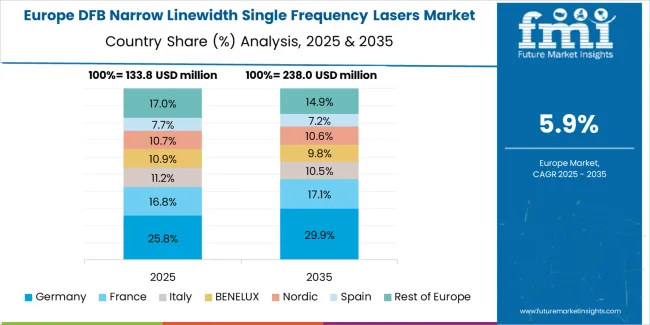
The DFB narrow linewidth single frequency lasers market in Europe is projected to grow from USD 145 million in 2025 to USD 275.8 million by 2035, registering a CAGR of 6.6% over the forecast period. Germany is expected to maintain leadership with a 28.5% market share in 2025, moderating to 27.9% by 2035, supported by precision optical manufacturing, automotive LiDAR development, and advanced industrial sensor applications.
The United Kingdom follows with 19.2% in 2025, projected at 18.7% by 2035, driven by telecommunications equipment manufacturing, research institution applications, and precision measurement systems. France holds 16.4% in 2025, inching up to 16.8% by 2035 on the back of telecommunications infrastructure and optical component integration. Italy commands 12.1% in 2025, rising slightly to 12.3% by 2035, while Spain accounts for 8.6% in 2025, reaching 8.9% by 2035 aided by fiber optic network expansion and industrial sensing applications.
The Netherlands maintains 4.8% in 2025, up to 5% by 2035 due to telecommunications hub operations and photonics research activities. The Rest of Europe region, including Nordics, Central & Eastern Europe, and other markets, is anticipated to hold 10.4% in 2025 and 10.4% by 2035, reflecting steady development in telecommunications infrastructure and emerging sensing applications.
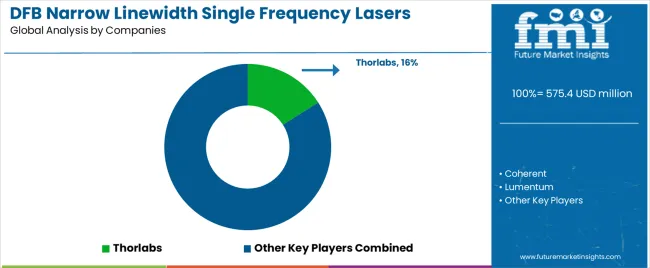
The DFB narrow linewidth single frequency lasers market is characterized by competition among established optical component manufacturers, specialized laser technology companies, and integrated photonics developers. Companies are investing in advanced semiconductor fabrication technologies, wavelength tuning capabilities, product portfolio expansion, and application-specific laser development to deliver high-performance, reliable, and cost-effective narrow linewidth laser solutions. Innovation in photonic integration methods, linewidth reduction techniques, and wavelength stabilization technologies is central to strengthening market position and competitive advantage.
Thorlabs leads the DFB narrow linewidth single frequency lasers market with 16% share with comprehensive narrow linewidth laser solutions focusing on telecommunications applications, precision measurement systems, and research instrumentation across diverse optical communication and scientific applications. Coherent provides advanced laser technologies with emphasis on industrial integration and medical applications. Lumentum delivers high-performance optical components focusing on telecommunications networks and data center coherent optics. Anritsu Group offers precision measurement instruments with comprehensive laser source capabilities for testing applications.
EMCORE Corporation provides specialized optical components with emphasis on fiber optic communication systems. MACOM specializes in high-frequency semiconductor solutions including narrow linewidth laser technologies. Mitsubishi Electric focuses on telecommunications equipment and optical component integration. Nanoplus Nanosystems And Technologies emphasizes specialty laser development for sensing applications. QD Laser offers quantum dot laser technologies for telecommunications networks.
Toptica Eagleyard provides precision laser sources for scientific instrumentation. Thorlabs specializes in optical component integration and research applications. G&H Photonics delivers advanced optical solutions for telecommunications and industrial markets. Optilab focuses on specialized laser technologies for measurement applications. Inphenix provides narrow linewidth laser sources for fiber optic systems. Shanghai Precilasers offers regional manufacturing capabilities. Connet Laser Technology specializes in optical component production. Sichuan Ziguan Photonics Technology focuses on telecommunications laser development. Wuhan 69 Sensing Technology emphasizes sensing application laser solutions.
DFB narrow linewidth single frequency lasers represent a specialized optical component segment within telecommunications and precision measurement applications, projected to grow from USD 575.4 million in 2025 to USD 1,080.1 million by 2035 at a 6.5% CAGR. These high-performance laser sources—primarily distributed feedback semiconductor configurations with sub-megahertz linewidth characteristics—serve as critical components in coherent optical communication, gas sensing, medical diagnostics, and precision measurement applications where narrow spectral width, frequency stability, and single-mode operation are essential. Market expansion is driven by increasing coherent optical network deployments, growing environmental sensing requirements, expanding quantum technology research, and rising demand for precision laser sources across diverse telecommunications and scientific instrumentation segments.
How Industrial Regulators Could Strengthen Product Standards and Performance Specifications?
How Industry Associations Could Advance Technology Standards and Market Development?
How DFB Laser Manufacturers Could Drive Innovation and Market Leadership?
How End-User Industries Could Optimize Laser Performance and System Integration?
How Research Institutions Could Enable Technology Advancement?
How Investors and Financial Enablers Could Support Market Growth and Innovation?
| Items | Values |
|---|---|
| Quantitative Units (2025) | USD 575.4 million |
| Output Power | mW-10mW, 10mW-20mW, Over 20mW |
| Application | Telecommunication, Gas Sensing, Medical, Data Center, Others |
| Regions Covered | East Asia, Europe, North America, South Asia, Latin America, Middle East & Africa, Eastern Europe |
| Countries Covered | China, India, Germany, Brazil, United States, United Kingdom, Japan, and 40+ countries |
| Key Companies Profiled | Thorlabs, Coherent, Lumentum, Anritsu Corporation, EMCORE Corporation, MACOM Technology Solutions Holdings, Inc. |
| Additional Attributes | Dollar sales by output power and application category, regional demand trends, competitive landscape, technological advancements in laser fabrication, linewidth reduction technologies, photonic integration development, and coherent optical system optimization |
The global DFB narrow linewidth single frequency lasers market is estimated to be valued at USD 575.4 million in 2025.
The market size for the DFB narrow linewidth single frequency lasers market is projected to reach USD 1,080.1 million by 2035.
The DFB narrow linewidth single frequency lasers market is expected to grow at a 6.5% CAGR between 2025 and 2035.
The key product types in DFB narrow linewidth single frequency lasers market are 10mw-20mw, mw-10mw and over 20mw.
In terms of application, telecommunication segment to command 42.8% share in the DFB narrow linewidth single frequency lasers market in 2025.






Full Research Suite comprises of:
Market outlook & trends analysis
Interviews & case studies
Strategic recommendations
Vendor profiles & capabilities analysis
5-year forecasts
8 regions and 60+ country-level data splits
Market segment data splits
12 months of continuous data updates
DELIVERED AS:
PDF EXCEL ONLINE
CW DFB Laser Chip Market Size and Share Forecast Outlook 2025 to 2035
Dental Lasers Market Growth – Industry Insights & Forecast 2024-2034
Urology Lasers Market Size and Share Forecast Outlook 2025 to 2035
Cosmetic Lasers Market
Surgical Lasers Market
Ultrafast Lasers Market Analysis - Industry Growth & Forecast 2025 to 2035
Veterinary Lasers Market Size and Share Forecast Outlook 2025 to 2035
Ophthalmic Lasers Market Analysis - Innovations & Forecast 2024 to 2034
Dermatology Lasers Market - Demand, Innovations & Forecast 2025 to 2035
Solid State Lasers Market Analysis - Growth & Forecast 2025 to 2035
Pulmonology Lasers Market
Mid-infrared Lasers Market Analysis - Growth & Trends 2025 to 2035
Semiconductor Lasers Market Insights – Trends, Growth & Forecast 2025 to 2035
Carbon Dioxide Lasers Market Size and Share Forecast Outlook 2025 to 2035
Quantum Cascade Lasers Market Growth - Trends & Forecast 2025 to 2035
Photostimulation Lasers Market
Dermatology Excimer Lasers Market Insights - Growth & Forecast 2025 to 2035
Vertical-Cavity Surface-Emitting Lasers (VCSEL) Market Growth - Trends & Forecast 2025 to 2035
Excimer and Femtosecond Ophthalmic Lasers Market Size and Share Forecast Outlook 2025 to 2035
Frequency Control and Timing Device Market Size and Share Forecast Outlook 2025 to 2035

Thank you!
You will receive an email from our Business Development Manager. Please be sure to check your SPAM/JUNK folder too.
Chat With
MaRIA